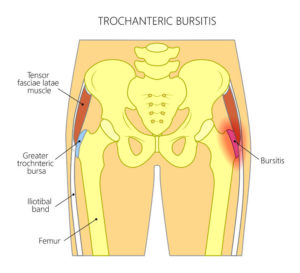 As the body’s largest ball-and-socket joint, the hip is designed to endure repeated motion and wear and tear. This natural flexibility makes it possible to walk, run, and bend without difficulty. However, like all joints, the hip sometimes suffers from injury or degeneration that leads to pain, discomfort, and decreased range of motion.
As the body’s largest ball-and-socket joint, the hip is designed to endure repeated motion and wear and tear. This natural flexibility makes it possible to walk, run, and bend without difficulty. However, like all joints, the hip sometimes suffers from injury or degeneration that leads to pain, discomfort, and decreased range of motion.
Hip bursitis is one such condition. Bursitis develops when a part of the joint called the bursaw become inflamed. Bursae are small, jelly-like sacs found in joints throughout the body. They hold a small amount of fluid and are situated between bones and soft tissue in order to reduce friction and provide cushioning during movement. When the bursae become inflamed and create bursitis, significant hip pain develops as a result.
By paying close attention for the symptoms of hip bursitis and seeking early diagnosis and treatment, you can protect your joints and maintain a full range of motion to support an unrestricted lifestyle.
Do You Have Hip Bursitis?
The main symptom of hip bursitis is hip pain outside of the lower part of the hip. It might feel like a sharp or searing pain that evolves into an ache over time. The pain associated with hip bursitis typically becomes worse after sleeping or being seated for a long period of time. Repetitive activity, hip tenderness, and radiating pain also signal hip bursitis.
Seek Diagnosis as Early As Possible
A diagnosis of hip bursitis cannot be made until other conditions are ruled out, including spinal stenosis, degenerative disc disease, hip osteoarthritis, and infection. To complete your diagnosis, you will undergo an interview, physical exam, X-ray or MRI, and lab tests. It is possible for hip bursitis to turn septic if the bursae become infected by a microorganism. Though not common, it does occur, and early diagnosis and treatment can ensure that you do not suffer from this issue.
Begin Treatment For Hip Bursitis
The early you begin treatment for hip bursitis, the quicker you can relieve your pain and start living a more active, comfortable life. In addition to rest, activity modification, ice, and NSAIDS, it is also possible to receive a corticosteroid injection to alleviate pain.
When minor treatments do not work, you can consider a bursectomy surgery to remove the affected bursa. Just call (941) 485-1505 to make an appointment at one the many locations of Suncoast Orthopaedic Surgery & Sports Medicine throughout Sarasota County. Suncoast Orthopaedic Surgery specializes in the diagnosis and treatment of athletic and degenerative conditions of the musculoskeletal system, so you will get the expert help you need.
